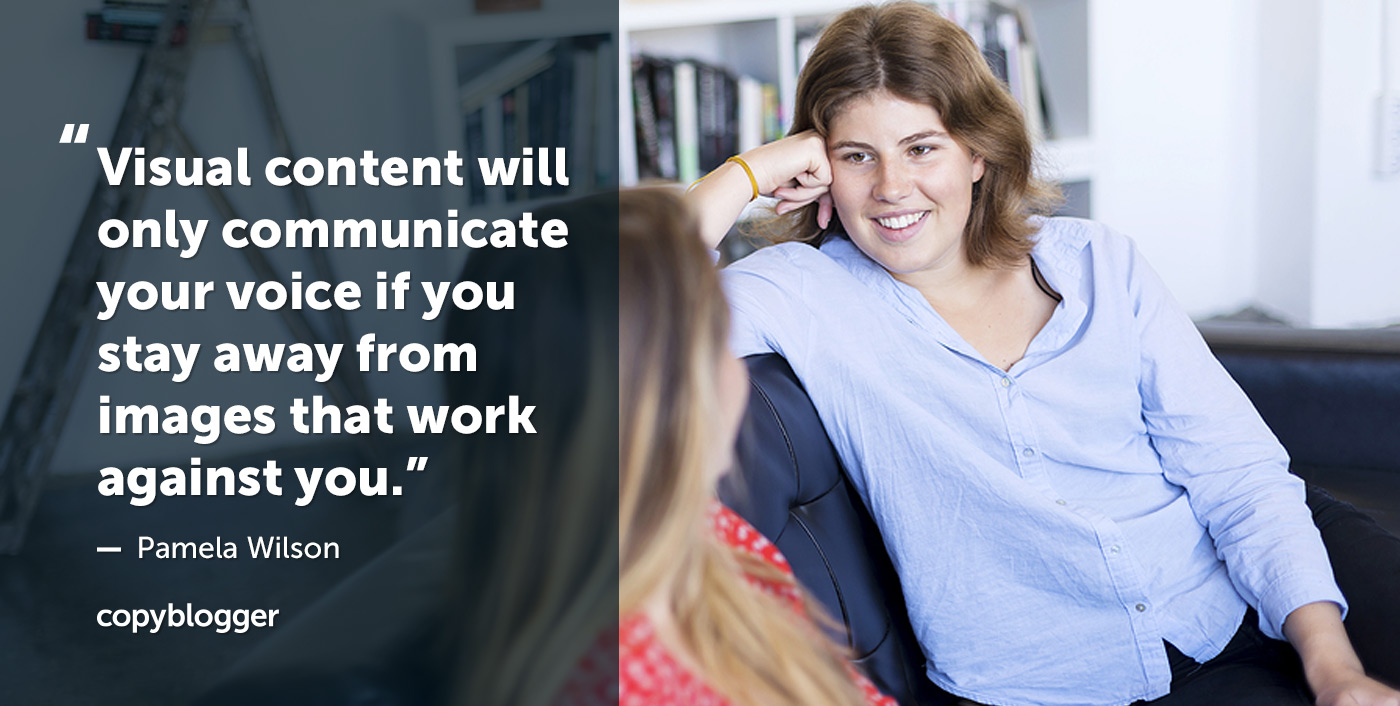Is it possible for something to be both a lifesaver and a minefield?
Yes — and if you’ve spent any time searching for the perfect image on a stock photo website, you know it’s true.
Stock photos are a lifesaver — they help you use powerful visual marketing to connect with your readers.
And stock photos are a minefield — the wrong image can cause you to lose credibility, attention, and trust.
This article shares four tips for avoiding those “stock photo landmines” that end up working against you rather than for you.
It’s worth the effort.
According to a study by MDG Advertising:
“Images are powerful on their own, but when mixed with text they become even more impactful.”
They also note that:
“Articles with relevant images get 94 percent more views, on average, compared to articles without images.”
Ninety-four percent more views?
I’ll take it. How about you?
Finding the right image is a lot of work: Why bother?
Quick question:
Why do you create content marketing?
Content marketing is how we build trust and authority. It gives our businesses a voice. It shows prospects and customers that there’s a relatable human being behind the company they’re engaging with.
Visual content marketing does these things too.
Visual content marketing builds trust and authority. It gives your business a voice. It demonstrates that your business is run by humans, for humans.
But visual content will only build trust and communicate your voice if you stay away from images that work against you.
Read on and learn what to avoid.
1. Stay away from flawless and fake
I’m all for flawless examples of humanity.
For better or worse, we aren’t surprised to see perfection in our movie stars, musical artists, fashion models, and social media influencers.
But when it comes to finding a stock photo to illustrate your authoritative piece of content, relatable always wins.
Which of the images below works to illustrate a piece of content about healthy attitudes toward food?


To stay away from flawless and fake:
- Avoid images where the models are retouched and “perfect.”
- Avoid images where the facial expressions look orchestrated.
- Avoid images where the situation seems unreal or like it’s happening on a movie set.
- Avoid images that look overly posed.
You’ll find this much easier to do if you understand the difference between two major categories of photos: posed and candid.
2. Know the difference between posed and candid photos (and look for candid)
Back when I worked as a creative director, I often hired photographers to photograph client events.
At these events, there were two types of photos they could take …
Posed photos, like this, where a photographer or art director obviously arranged the subjects and asked them to do something specific for the camera:

… Or candid photos, like this, where the subjects appear unaware that someone was taking their photo:

Without exception, when the images came back, the candid photos were so much more interesting.
They captured the spirit of the event — the emotions of the attendees. They showed the small moments that told big stories.
Keep this in mind as you look at stock photos.
Do they look posed or candid?
Candid photos almost always look more natural, more real, and more relatable. Search for those, and avoid images that look posed.
3. Identify the emotion you want to convey before you search
You’re reading Copyblogger, so I know you’re a writer.
Before you start swimming around in thousands of image possibilities, take 30 seconds to think about analogies.
Ask yourself:
- What emotion do I want to convey with the photo?
- What emotion do I want the viewer to feel when they see it?
- What situation would convey that emotion?
For example, if you want to show the word “security,” you could choose an obvious symbol of security like a safe:

Or you could show the feeling of security using a relatable photo of a person (or even an animal) with facial expressions and body language that show what security feels like:

Which one conveys the emotion best?
4. Avoid visually busy images
Once you know what concept you want to communicate, get choosy about your search results and aim for simplicity.
We combine fonts, colors, and photos when creating visual marketing, and the final product can be multilayered and complex.
That’s why it’s important to start with a visually simple photo of the concept or emotion you want to express.
Rather than choosing a visually complex photo, like this, to show how working from a coffee shop is an option for online business owners:

… Look for a photo that conveys the same basic concept but with imagery that’s simple and direct:

When comparing two photo results, avoid the visually busy ones and choose the simplest possible version.
Read this next section with your best “mom voice”
You know what’s really cringeworthy?
Getting a legal notice from the owner of an image you’ve used without permission — and having to pay thousands of dollars in legal fees due to your carelessness.
That’s why I want you to read this section in your best “mom voice,” because that’s how I’m writing it.
Listen …
Just because you know how to right-click and save an image doesn’t mean you’re allowed to.
I’m pretty sure that as a content marketer, you don’t want someone to copy/paste your words and use them without your permission.
Photographers feel the same way about their photography — as they should.
Their creative work is just as valuable as yours.
Let’s vow to treat each other as creative professionals — and respect intellectual property when we come across it online.
Besides, it’s so easy to find free and inexpensive stock photography that’s ready for you to use with full rights.
There’s no excuse for swiping and using an image without permission.
Improve your photo search skills and put them to use on the many free and paid stock photo sites available today.
Become a confident visual marketer: register for this free on-demand workshop
Learn more about choosing and using photos to promote your business online with my free on-demand workshop, Brand Your Business with Stunning Visuals in 30 Minutes or Less.
Register and you can start watching (and learning) in just a few minutes.
The workshop is chock-full of dozens of examples of images I developed for the Copyblogger blog. Discover a simple method that you can use to put together gorgeous visual marketing — even if you’re not a designer.
Visual marketing mastery is within the reach of anyone!
Click the button below to get started today:
Editor’s note: Copyblogger is an affiliate for Pamela’s workshop.

Reader Comments (13)
The lady posed with strawberries though!
I know, right?
The model is super cute and has a ton of energy.
I’m going to say that photo was a case of bad art direction. I’d love to see her in a candid pose!
I never heard tip #4 before. Thanks for that, Pamela.
Simple images are faster and easier to scan: it’s the same concept as editing wordy copy. Pare it down and you get to your point faster!
Wonderful writeup Pamela.
One thing I felt so embarrassing so far that – the stock photos (free or paid, both). I found my images have been used hundreds of similar niche websites.
What do you think about what the visitors might be thinking who is from same (niche) industry about those images?
Shamim, it’s a real problem.
This is one reason I teach a technique for customizing images so you can make them unique to your business. By the time you add color, text, and your logo, the photo becomes your own unique creation.
I call them “signature branded images” for that reason!
My favorite subgenre of cheesy stock image is “women eating salad and laughing.”
I mean, I actually really like salad, but I just don’t get that big a chuckle out of it.
“Woman eating salad and laughing while sitting on a beach in a cocktail dress at sunset.”
Pretty sure there’s a whole category for this kind of image. Yikes!
Whenever I see some whack stock photos, I can’t take the content seriously. Thank you for this!
As a reader, I’d definitely agree with the #2. Candid clicks have just another kind of engaging power!
I add a solid color/gradient layer of 80% opacity on any stock image I choose for my blog post’s featured image. Is that a great step?
Excellent piece!
#2 is my pet peeve! It’s really a symptom of #1. By far the worst offender is a “customer service” or similar piece that uses a stock photo with a model wearing a headset.
Photography is about capturing a moment/emotion in time and posed photos are overly staged to the point of unbelievable and thus inauthentic.
I wonder if this overly posed imagery came out of companies wanting to appear neutral but at the same time, trying to convey a sense of “fun”? Sorry corporate suits, you can’t fake authenticity.
This article's comments are closed.